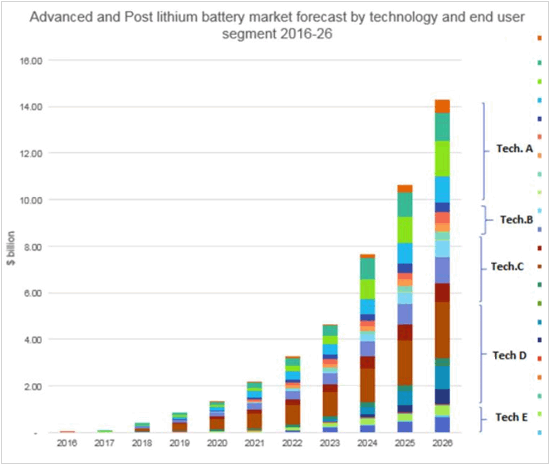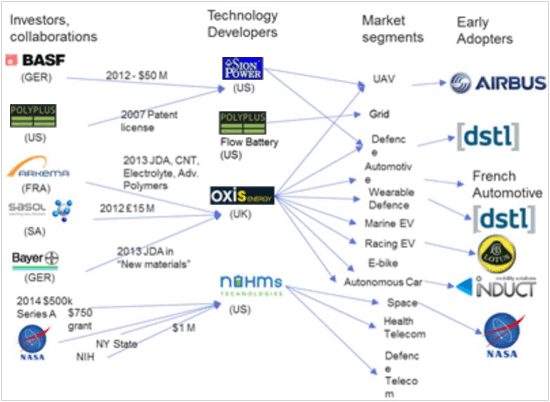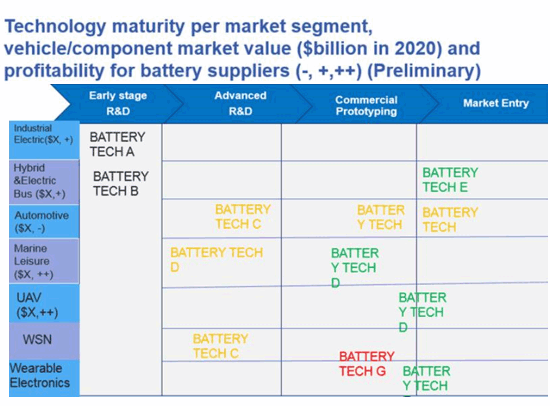2016-2026年先进及post锂离子电池技术,市场及未来预测(英文)
锂离子电池, Lithium-ion Batteries
http://www.bimarket.cn/Report/ReportInfo.aspx?Id=2
2015/10/12 10:21:09
报告链接:http://www.bimarket.cn/Report/ReportInfo.aspx?Id=24607
Advanced and post Lithium-ion batteries will account for $14 billion by 2026.
Lithium-ion is the best battery technology we have ever seen. It has increased energy density by 5% per year and decreased its cost at 8% per year. However it will not achieve transformative factors of five in cost and performance and this is just because of the inherent material limitations.
A new generation of battery technologies will be required in order to address the existing and future challenges of the increasingly complex energy systems our society will require in the future.
Better batteries will be required not only in electric cars and consumer electronics but in wearable electronics, electric vessels and aircrafts, in your house, office and communities.
Whilst existing battery technologies such as lead acid and lithium-ion batteries will dominate the battery market in the following 10 years, advanced and post lithium-ion batteries given the right conditions can potentially take a considerable dent of about 10% of whole battery market. This is mostly because some of them are already in use in niche segments that will present high growth in the following 10 years.
This report focuses in advanced and post lithium-ion battery technologies: silicon anode batteries, solid state batteries, sulphur batteries, lithium air batteries, sodium-ion batteries and magnesium batteries. A performance benchmark is presented based in practical results achieved so far from different organisations from start-ups, established companies and research organisations. We analyse challenges and commercial strategies by the companies developing them and provide a 10 year market forecast, 2016-2026. We provide company profiles of the key companies involved in the development and commercialisation of these technologies. Our coverage is global including activities from the US to Asia.
IDTechEx builds upon its 15 years' experience in analysing 45 electric vehicle segments, the future of electronic devices and emerging energy storage technologies in order to provide a comprehensive analysis of the current state of development of these technologies and its market potential. We have conducted several interviews with key companies and organisations developing these technologies and attended the key conferences around the world in which highlights of these technologies have been presented.
Figure 1 - Forecast 2016-2026 Technology per market segment
(full chart included in the report)

Source: IDTechEx report "Advanced and Post Lithium-ion Batteries 2016-2026".
Figure 2 - Battery value chain players

Source: IDTechEx report "Advanced and Post Lithium-ion Batteries 2016-2026".
Figure 3 - Technology maturity per market segment

Source: IDTechEx report "Advanced and Post Lithium-ion Batteries 2016-2026".
TABLE OF CONTENTS
Table of Contents
1. EXECUTIVE SUMMARY
2. WHY POST LITHIUM ION BATTERIES NOW?
2.1. Why Post Lithium Ion batteries now 2015?
2.2. Lithium ion batteries are only incrementally improving
2.3. Key cell manufacturing improvements in Li ion between 2007 and 2012
2.4. Li ion performance will plateau even with new materials
2.5. Interest in post Li ion batteries has been rising
2.6. What are post Li ion battery technology candidates?
3. CHALLENGES FOR POST LITHIUM ION BATTERIES
3.1. Challenges for Post Lithium Ion Batteries
3.2. Barriers for new start up battery companies: Automotive vs Alternative Niche Segments
3.3. Mainstream market requirements: Performance and price
3.4. Cluster challenges for cost competitiveness
3.5. Automotive Lithium Battery Price evolution at pack level
4. ADDRESSABLE MARKET FORECAST 2016-2026
4.1. Addressable battery market by end user segment in $ billion
4.2. Comments on forecast chart
4.3. Battery volume demand in GWh by end use segment 2015-25
4.4. Profitability estimation of alternative niche segment
5. POST LITHIUM ION TECHNOLOGIES
5.1. Technologies of Post Lithium-Ion Batteries
5.2. Technology maturity roadmap per market segment
5.3. Benchmarking of theoretical battery performance
5.4. Benchmarking of practical battery performance 2015
6. SILICON ANODE BATTERIES
6.1. Why Silicon anode batteries?
6.2. Silicon anode
6.3. Key suppliers/developers of silicon anode materials
6.4. Selection of silicon anode materials by manufacturing process and company/organisation (1)
6.5. Chemical companies involved in silicon anode materials (selection)
7. MARKET FORECASTS FOR SI ANODE BATTERIES
8. LITHIUM SULPHUR BATTERIES
8.1. Why Lithium Sulphur batteries
8.2. Lithium Sulphur Batteries
8.3. Lithium Sulphur batteries: Pros and Cons
8.4. Lithium Sulphur - Polysulphides solubility issue
8.5. Solutions proposed to sulphur battery challenges à Electrolyte approaches
8.6. Case Study: Oxis Energy
8.7. Oxis Energy - technology development paths
9. MARKET FORECASTS FOR LI-S BATTERIES
9.1. Lithium Sulphur Battery Market Forecast
9.2. Solid State Batteries
9.3. Why Solid State batteries?
10. SOLID STATE BATTERIES
10.1. Solid electrolytes by ionic conductivity and temperature
10.2. Lithium ion batteries vs Solid state batteries
10.3. Solid state thin film battery products today
10.4. Different generations of solid state batteries
10.5. Solid state materials and companies/organisations working on them
10.6. Solid state materials and companies/organisations working on them.
11. SOLID STATE BATTERY FORECASTS
12. LITHIUM CAPACITORS
12.1. Lithium capacitor
12.2. Nomenclature
12.3. Supercapacitors and Hybrid supercap.
12.4. Nano hybrid capacitor (NHC)
12.5. Hybrid Supercapacitors evolution
13. LITHIUM CAPACITOR FORECAST
14. SODIUM ION BATTERY FORECASTS
15. LITHIUM AIR/O2 BATTERIES
16. MAGNESIUM BATTERIES
16.1. Magnesium insertion anodes
16.2. Electrolytes for Mg anodes
16.3. Developments in magnesium metal anode batteries
16.4. Magnesium metal anode electrolyte developments
17. SUMMARY OF TECHNOLOGY CHALLENGES
18. COMPANY PROFILES
18.1. Amprius
18.2. Bess-tech
18.3. California Lithium Battery Inc (CalBattery)
18.4. EnerG2
18.5. Enevate Corporation
18.6. Enwair Energy Technologies Corp
18.7. Faradion
18.8. Furukawa Electric Group
18.9. Grafentek
18.10. Graphenea
18.11. Ilika Technologies
18.12. JSR Micro, Inc
18.13. Nexeon Ltd
18.14. NOHMs
18.15. OneD Materials LLC
18.16. OXIS Energy
18.17. Sakti3
18.18. SolidEnergy
18.19. Wildcat Discovery Technologies
18.21. XG Sciences
18.22. Yunasko Ltd
18.23. Zeptor Corporation
报告链接:http://www.bimarket.cn/Report/ReportInfo.aspx?Id=24607